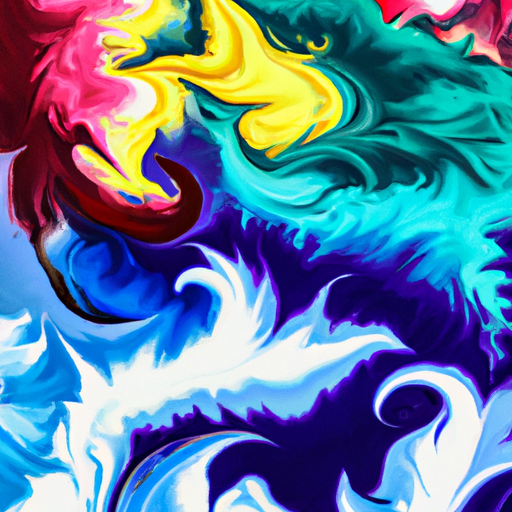Understanding the Symbolism in Abstract Art
Understanding the Symbolism in Abstract Art is crucial for decoding the language of abstract. Abstract art, characterized by its non-representational and non-objective nature, often leaves viewers perplexed and searching for hidden meanings. Artists use various forms, colors, lines, and textures to express their thoughts and emotions, making abstract art a rich tapestry of symbolism.
One of the key elements to understanding the symbolism in abstract art is recognizing that there is no right or wrong interpretation. Each viewer brings their own experiences, emotions, and perceptions, which shape their understanding of the artwork. This subjectivity allows for a personal and unique connection between the viewer and the artwork.
The use of color in abstract art is a powerful tool for expressing emotions and creating symbolism. Warm colors like red, orange, and yellow often evoke feelings of energy, passion, and warmth, while cool colors like blue and green can convey serenity, tranquility, and even sadness. Artists may also use contrasting colors to create tension or harmony within their work. Such color choices can provide cues to the underlying meanings in the artwork.
Another important aspect of understanding symbolism in abstract art is the interpretation of shapes and forms. Geometric shapes, such as squares, circles, and triangles, can represent stability, balance, and order. Organic and curvilinear forms, on the other hand, may convey freedom, fluidity, or even chaos. The interaction between shapes and forms within the composition can further enhance the symbolic meaning of the artwork.
Lines play a significant role in abstract art as well. Straight, vertical lines often suggest strength, stability, or authority, while horizontal lines may imply calmness or tranquility. Diagonal and curved lines can introduce movement, fluidity, or dynamism into the artwork. Artists carefully manipulate lines to convey specific emotions or concepts.
Textures also contribute to the symbolism in abstract art. Rough or jagged textures can symbolize turmoil or struggle, while smooth or sleek textures may evoke feelings of harmony or elegance. By incorporating different textures into their artwork, artists add layers of meaning and depth.
Understanding the symbolism in abstract art requires an open mind and a willingness to engage with the artwork on a deeper level. Each brushstroke, color choice, and composition decision is purposeful and carries significance. By exploring the various elements and principles of abstract art, viewers can decipher the hidden meanings and interpret the artwork in their own unique way.
Delving Into the Enigmatic World of Abstract Expressionism
Delving Into the Enigmatic World of Abstract Expressionism: Decoding the Language of Abstract Art
Abstract art has long fascinated and perplexed both art lovers and critics alike. What is the meaning behind those bold strokes, vibrant colors, and seemingly chaotic compositions? One particular movement that has caused much contemplation and debate is abstract expressionism. In this article, we will delve into the enigmatic world of abstract expressionism and explore the hidden meanings behind this captivating art form.
Abstract expressionism emerged in the mid-20th century in New York City and quickly gained prominence as a significant movement in contemporary art. It was characterized by its emphasis on spontaneous, gestural brushwork, and the absence of recognizable subject matter. The artists who championed this style sought to convey their inner emotions, thoughts, and experiences through their creations.
One of the key concepts in abstract expressionism is the idea of non-representational or non-objective art. Unlike traditional art forms that aim to depict a specific subject or tell a story, abstract expressionism focuses on the pure emotional and psychological impact of the artwork. Artists often use abstraction as a means to explore their subconscious and express their innermost feelings.
Color plays a vital role in abstract expressionism, with artists carefully selecting hues to evoke certain emotions or create specific visual effects. Bold, vibrant colors are often employed to elicit strong sensations or to create a sense of movement and energy within the composition. On the other hand, somber, muted tones may be used to convey a sense of melancholy or introspection.
The use of texture and brushwork is another significant aspect of abstract expressionism. Artists experiment with different techniques, such as layering paint, adding impasto, or creating textural effects through scraping or scratching the surface. These techniques add depth and complexity to the artwork and invite the viewer to engage with it on a sensory level.
Interpreting abstract expressionist artworks can be a highly subjective and personal experience. Each viewer brings their own unique perspective, emotions, and experiences to the artwork, which can influence their interpretation. Some may see a burst of energy and vitality, while others may perceive a serene landscape or a tumultuous emotional state. The beauty of abstract expressionism lies in its ability to evoke a wide range of emotions and elicit diverse responses.
Decoding the language of abstract art requires an open mind and a willingness to explore beyond the surface. While there may not be a definitive meaning behind every brushstroke or color choice, abstract expressionism encourages viewers to connect with their own inner selves and find personal significance in the artwork.
As we delve deeper into the enigmatic world of abstract expressionism, we begin to unravel the hidden meanings and appreciate the power of this art form. It stands as a testament to the human ability to convey complex emotions and experiences through non-representational forms.
In conclusion, abstract expressionism offers a profound and unique language of artistic expression. Its emphasis on emotion, color, texture, and gesture invites viewers to explore their own interpretations and tap into their inner worlds. Whether abstract art is a mystery or a revelation, one thing is certain – it continues to captivate and inspire, leaving us in awe of the boundless possibilities of artistic expression.
Analyzing the Subtext of Colors and Brushstrokes in Abstract Art
Analiza podtekstu kolorów i maniery malarskiej w sztuce abstrakcyjnej jest jednym z kluczowych aspektów, które pomagają odkryć ukryte znaczenia w tego rodzaju dziełach. Artystyczne wybory kolorów i techniki użyte do kreacji obrazu mogą zawierać głębokie przesłania i wpływać na odbiór artystycznego dzieła.
Kiedy analizujemy podtekst kolorów w sztuce abstrakcyjnej, warto zwrócić uwagę na ich emocjonalne oddziaływanie. Każdy kolor niesie ze sobą określone skojarzenia i odcienie znaczenia. Na przykład, czerwień może symbolizować pasję i energię, podczas gdy niebieski może kojarzyć się z spokojem i refleksją. Artysta może świadomie dobierać poszczególne kolory w celu wywołania określonych emocji u widza.
Analizując manierę malarską w sztuce abstrakcyjnej, warto zwrócić uwagę na różnorodność technik i stylów wykorzystanych przez artystę. Sposób, w jaki artysta prowadzi pędzlem, nakłada farbę na płótno, tworzy teksturę i kompozycję, może przekazywać wiele informacji na temat intencji artysty. Na przykład, dynamiczne i energiczne pociągnięcia pędzla mogą wskazywać na ekspresję i ruch, podczas gdy delikatne i wyrafinowane ruchy mogą oznaczać subtelne emocje.
Ważnym elementem analizy podtekstu kolorów i maniery malarskiej jest również uwzględnienie kontekstu historycznego i kulturowego, w którym powstało danego dzieło. Interpretacja i zrozumienie tego, co artysta chciał przekazać, może być ułatwione poprzez uwzględnienie kontekstu czasowego i społecznego.
Decydując się na analizę podtekstu kolorów i maniery malarskiej w abstrakcyjnej sztuce, warto mieć na uwadze, że interpretacja jest w dużej mierze subiektywna i zależy od indywidualnej percepcji widza. Każdy może dostrzegać i odczuwać coś innego w danym dziele, co sprawia, że sztuka abstrakcyjna jest tak fascynująca i otwarta na różne interpretacje.
Analiza podtekstu kolorów i maniery malarskiej w abstrakcyjnej sztuce jest nieodłącznym elementem odkrywania ukrytych znaczeń i rozumienia intencji artysty. Poprzez uwzględnienie emocjonalnego oddziaływania kolorów oraz analizę technik malarskich, można odkryć różnorodne interpretacje i przekaz zawarty w artystycznym dziele. Sztuka abstrakcyjna nieustannie zachęca do poszukiwania własnego odczytania i doceniania piękna, które nie zawsze musi kojarzyć się z konkretnymi formami czy przedstawieniami.
Deciphering the Visual Language of Abstract Compositions
Deciphering the Visual Language of Abstract Compositions is a captivating journey into the world of abstract art, where the canvas becomes a playground for expression and the viewer is invited to interpret the hidden meanings behind the artwork. Abstract art is often characterized by its non-representational nature, using shapes, colors, and lines to convey emotions and ideas.
One key aspect of deciphering abstract art lies in understanding the artist’s use of visual elements. Shapes, for instance, can hold symbolic representations that contribute to the overall message of the artwork. Circles may signify unity and harmony, while jagged lines can evoke feelings of tension or chaos. By analyzing the shapes present in an abstract composition, we can begin to unravel the artist’s intention.
Colors also play a crucial role in decoding the visual language of abstract art. Each color carries its own symbolic meaning, and artists often use them deliberately to convey certain emotions or concepts. Red, for example, can signify passion and intensity, while blue may evoke feelings of calm and tranquility. By examining the color palette chosen by an artist, we can gain insight into the intended mood or atmosphere of the artwork.
Furthermore, lines serve as powerful tools in abstract compositions, guiding the viewer’s eye and creating a sense of movement within the artwork. Horizontal lines can suggest stability and balance, while diagonal lines might convey energy or dynamism. By studying the direction, thickness, and placement of lines, we can uncover the artist’s desired visual impact.
Decoding the visual language of abstract art also requires an exploration of the artist’s techniques and materials. The way paint is applied, the texture of the surface, and the use of different mediums all contribute to the overall aesthetic experience. These elements provide valuable clues into the artist’s process and can deepen our understanding of their artistic intention.
Ultimately, deciphering the hidden meanings in abstract art is a personal and subjective journey. While some artworks may have clear interpretations, others invite multiple perspectives and encourage individual exploration. The beauty of abstract art lies in its ability to provoke emotions and thoughts without relying on literal representations.
By delving into the visual language of abstract compositions, we open ourselves to a world of endless possibilities and interpretations. As we embark on this exploration, we begin to appreciate the depth and complexity that abstract art has to offer, allowing us to engage with it on a profound level.



